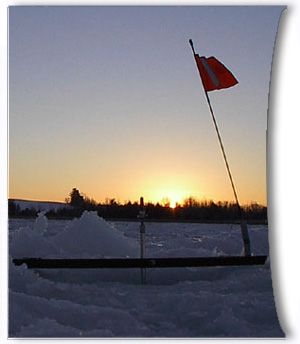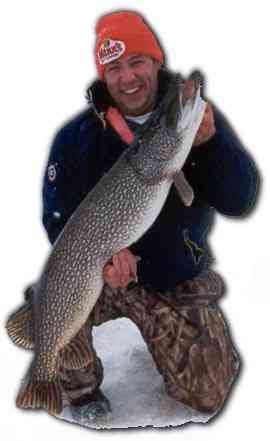
|
Home | Cover | Contents |
Scientific Set-Lining for More PikeBy JP Bushey |

|
Tip-ups and other live bait delivery systems are a crucial component of pike fishing through the ice. Stationary live bait rigs fill an important niche, and when used in conjunction with jigging techniques, help anglers to zero in on the location and activity level of pike during the winter season. Set-line fishing with live or dead minnows is often associated with notions of a "sit and wait" game; lacking in efficiency and entertainment. It is often viewed as a lazy way to fish. Truth be known, more and larger pike are caught on minnows than any other ice fishing presentation. When applied precisely, set-line fishing can produce not only the biggest pike of the winter, but the biggest of your entire season as well. |
|
Most regions allow for the use of two fishing lines during the ice fishing season. Multiplied over three or four anglers, the prospects for covering water become impressive. Just as with trolling or casting, successful set-lining is all about the systematic probing of as many potential depth and cover zones as possible. Once a spot has been selected, a considerable amount of time must be devoted to "surveying" it. I like to carry a pocketful of cardboard squares and a magic marker. As soon as the holes have been cut, and one should be prepared to cut several, use a portable flasher or LCR unit to find the depth in each. Record the depth on the cardboard and secure it in the slush nearby. Having a clear mental image of the area you're fishing will help you to set your lines in the best holes. Before long, you'll be able to reshuffle your lines, based on the feedback (or lack of) each hole provides. After a few days, you will be able to really pinpoint what depth the fish are using, and which holes are simply in dead water. Cutting 15 to 40 holes per outing is not uncommon. The key is to eliminate those holes which fail to produce and to exploit those which provide the most action. There is a fine line between confidence and stubbornness in set-line fishing; knowing where and when to move can make all the difference in the world. Only experience can tell you when to stick with it, or when to move on. As a rule, I like to set my lines from deep to shallow. Though cutting holes seems to have a minimal effect on pike, I prefer to start the commotion over deeper water. Some old-timers believe that the sound of the chisel actually serves to rouse a pike's interest. When setting out the lines, be prepared to set up each line completely before moving on to the next hole. Have everything you'll need with you. This will help you to stay efficient. Even the hungriest pike can't get your minnow if it isn't down the hole! Carry the slush spoon, minnow bucket, bottom finding device, hooks, sinkers and leaders on a small sled so that your minnow spends the optimal length of time in the strike zone. Having a flag go off before the other lines are even set is common when pike fishing. This is always a welcome surprise. As a general rule, pike tend to hold either within two feet of the bottom, or somewhere in the neighborhood of half way down through the water column. When fishing water shallower than 15 feet, such as during last ice, pike tend to hold tighter to the bottom. Conversely, fish found in deeper water tend to roam a lot higher. Pelagic forage, such as smelts and ciscoes, share a deep connection with northern pike in lakes where they coexist. This is especially true of trophy pike. Wherever the fish are holding, precisely placing the bait is of paramount importance. Failing to duplicate the exact level at which the bait was set can ruin a potential multiple-fish outing. The deeper the pike are, the more critical depth control/duplication becomes. In shallow water, pike can track and catch minnows far easier than if they're twenty feet above or below them. Use a heavy, fast sinking weight to locate the bottom and position your minnow accordingly. A 3/4oz. jig and grub combo can be clipped directly to the leader. At least once a season, you'll be pleasantly surprised by a sharp rap on the line while lowering or raising this fish-catching bottom finder. Set the depth of the minnow in relation to the bottom, and mark it clearly on the line. I've been using Spiderwire Fusion on my tip-ups for several years now, and it performs beautifully. Use a black magic marker to mark the desired depth; it shows up nicely on braided line for easy referencing. Ice fishing guru Dave Genz has a line of commercial markers that involve a sliding bead which can be pegged to denote specific depths. At one time or another, I've also used correction fluid, small scraps of electrical tape or rubber bands to mark my line, and they all do the job. The key is to set (and reset) your baits as precisely as possible. Nothing will kill your confidence faster than not knowing exactly where your minnow is positioned. When the fishing is tough, adjustments of less than twenty-four inches are often needed. Once a pike has been landed, return a fresh minnow to the marked depth. Though not known as a schooling fish, I firmly believe that pike do in fact move and hunt together in loose packs. This occurs along specific routes, usually a deep weedline, channel edge or transition area from a feeding flat into the main basin of the lake. By cutting your holes in a grid-like pattern, these contours can be identified. Staggering set-lines along one of these travel routes is one of the most reliable ways to catch pike in winter. Turns or areas where there are irregularities are key spots. Despite the covering of ice, fisherman can learn a lot about a lake's structure when they can probe in from a stationary position. Winter is a prime time to identify small hotspots that pike move into and out of all day long. Double and even triple-headers are possible in such areas. Though tackle requirements for set-lining are basic, there are major considerations that will help your fishing. Whether on a commercial tip-up, a homemade version or a simple limber twig and spool, monofilament line really isn't a good choice. It is too stiff, and too difficult to see on snow. Improvements in braided line technology have truly become one of ice fishing's greatest assets. Opaque in color, they are easy to see, and coils can be removed by simply running the line through your fingers under some pressure. Spiderwire Fusion as well as the original braid are two of the best. Berkley Fireline is also a good product. The sensitivity of this line offers the set-liner many advantages. First and foremost, taking up the slack after a pike has peeled off yards of line is easy; you are in direct contact with the end of the line from any distance. This means that anglers can feel exactly what the minnow or the fish is doing at any moment. A dead weight sensation usually means that the fish has turned the bait, and is preparing to swallow it. Conversely, a series of taps or pecks means that the pike has yet to get a firm hold on the minnow, and the hook set should be delayed. Setting the hook with braided line involves little more than a smooth series of hand over hand pulls to sink the barb and maintain tension on the line. Select leaders that are flat black. While just as many fish would probably smack a minnow baited on a bright, silver leader, your goal should be to present the bait as naturally as possible. These leaders are readily available. I like to modify them slightly, by downsizing the snap. A heavy snap and large hook can greatly inhibit a minnow's ability to swim freely. Ninety percent of my pike fishing is done with small treble hooks. Eagle Claw models in sizes 6 to 8 stick and hold even the biggest pike. You don't need a large, heavy hook to catch a big pike. Small trebles dig in and hold anywhere they touch, and allow the bait to remain much more lively. Excalibur Rotating trebles are good, in that their fine-wire construction is very easy on the minnow. Quick-strike rigs should be reserved for dead and/or frozen bait. I've found that they just do too much damage to live minnows. In late March, a Windlass Tip -Up baited with an oversized frozen smelt or herring on a wire quick-strike is simply deadly.
A steady cadence of flicks and tugs on the end of your line will ensure that a pike will find the bait. When fishing in a shack, looping the line over a length of straightened coat hanger wire, fixed at eye level, lets the angler know the minnow's pulse! Check your baits constantly. A little lift can wake up the minnow, and get him swimming again. On most days, a lazy minnow should be changed immediately. There are days, when motionless baits can draw strikes. Dead or lifeless baits used in conjunction with "wind-bobber" style tip-ups can be deadly. The periodic jerks and jumps imparted by the wind keeps even stubborn minnows fighting. Day in and day out though, lively minnows produce best. Cold water means that your minnows will perform much better. Those delicate, "one cast wonder-shiners" really toughen up in cold water. In spring and summer, chubs and suckers are usually a live bait fisherman's only real option. Shiners are excellent for pike fishing through the ice, and virtually every lake contains one or more species. I've caught pike on emerald, golden, red-fin and common shiners. I've never been a fan of outsized minnows, mainly because their hooking percentage is quite low. A 4" to 7" minnow will interest (and hook) even the biggest pike. My biggest to date, just under twenty-four pounds, came on a 4" common shiner.
|

